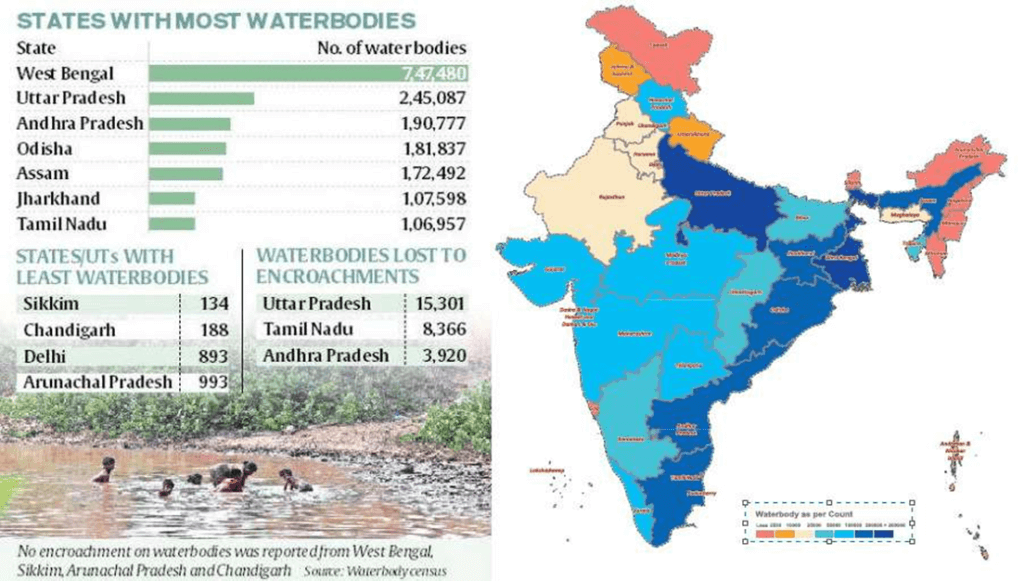The Ministry of Jal Shakti in India has recently released a report on the first-ever water body census in the country. This census is a database of water bodies that provides detailed information about ponds, tanks, lakes, and reservoirs. The census was conducted in 2018-19 and is the first time that such an exercise has been carried out in India.
Definition of a Water Body
In this census, all natural or man-made units used for storing water for irrigation or other purposes are treated as water bodies. This includes structures where water from ice-melt, streams, springs, rain or drainage of water, nala or river is stored.
However, there are exceptions such as oceans, lagoons, rivers, streams, springs, waterfalls, canals, swimming pools, covered water tanks created for specific purposes, temporary water bodies created by digging for mining, brick kilns, and construction activities, and pucca open water tanks created only for drinking for cattle.
Need for a Water Bodies Census
Until now, the Centre used to maintain a database of only those water bodies which were being provided Central assistance under the Scheme of Repair, Renovation and Restoration (RRR) of water bodies. The government launched the first census of water bodies in 2018-19 in convergence with the sixth minor irrigation census. The water body census was necessary to gather accurate information on the availability of water resources in the country and to identify the areas that need improvement in terms of water conservation and management.
Data Collection
Traditional methodology, i.e., paper-based schedules were canvassed both for rural and urban areas for the census of water bodies. Three schedules were prepared to collect information on water bodies: village schedule, urban schedule, and water body schedule. In addition, a smartphone was used to capture latitude, longitude, and photographs of water bodies.
Main Findings of the Water Bodies Census
According to the water body census report, India has 24.24 lakh water bodies like ponds, tanks, and lakes. West Bengal has the most number of water bodies at 7.47 lakh, while Sikkim has the least at 134. Among the Indian states, West Bengal has the highest number of ponds and reservoirs, while Andhra Pradesh has the highest number of tanks. Tamil Nadu has the highest number of lakes, and Maharashtra is the leading state for water conservation schemes.
Encroachment of Water Bodies
The census also collected data on encroachment of water bodies for the first time. Uttar Pradesh accounted for the most encroachments, followed by Tamil Nadu and Andhra Pradesh. On the other hand, no encroachment on water bodies was reported from four states — West Bengal, Sikkim, Arunachal Pradesh, and Chandigarh.

Why In News
The Ministry of Jal Shakti’s release of the first-ever water body census report provides a comprehensive understanding of the water bodies in India, including encroachment data, and highlights the need for their preservation.
MCQs about First-Ever Water Body Census in India
-
What is the water body census?
A. A database of water bodies in India
B. A survey of water quality in India
C. A study of ocean currents in India
D. A report on rainfall patterns in India
-
What is the definition of a water body in the census?
A. All natural or man-made units used for storing water for irrigation or other purposes
B. Any structure that contains water
C. Any body of water that is visible from space
D. Any body of water that is deeper than 10 meters
-
Why was there a need for a water bodies census?
A. To maintain a database of water bodies that receive Central assistance
B. To study the effects of climate change on water bodies
C. To monitor water quality in India
D. To promote tourism in areas with water bodies
-
Which state has the highest number of ponds and reservoirs?
A. Maharashtra
B. West Bengal
C. Andhra Pradesh
D. Tamil Nadu
Boost up your confidence by appearing our Weekly Current Affairs Multiple Choice Questions
![]()


